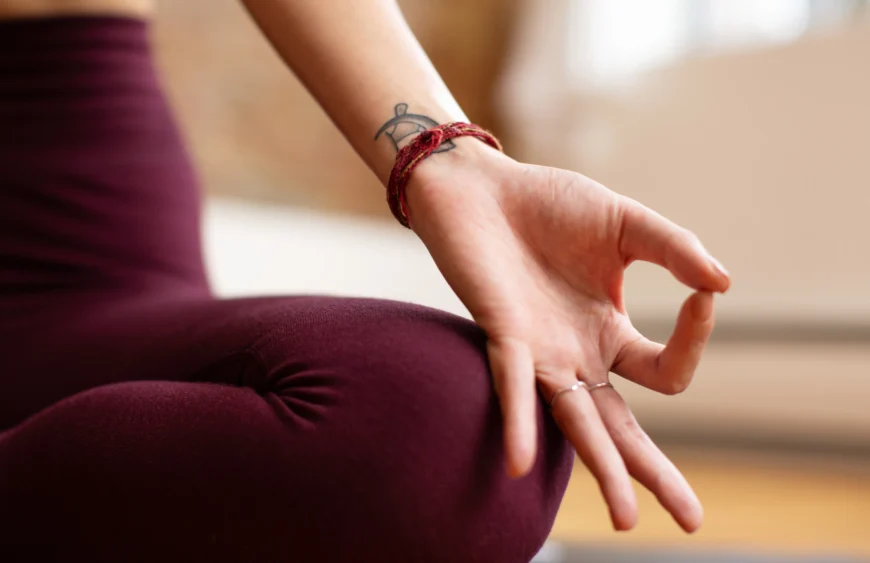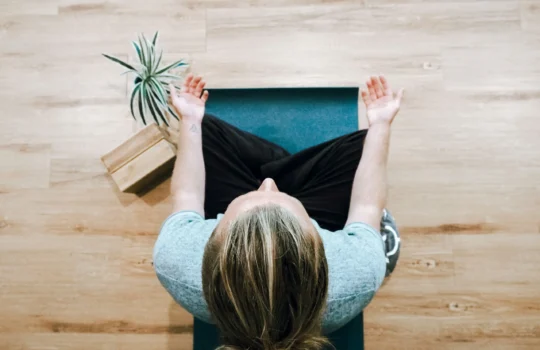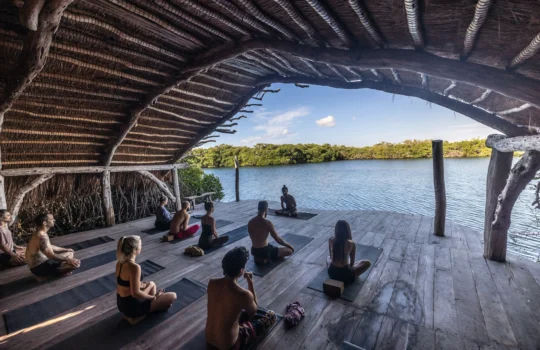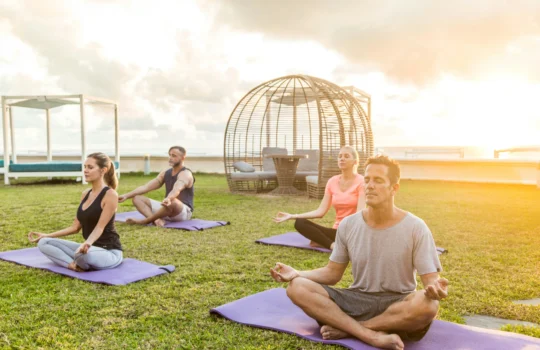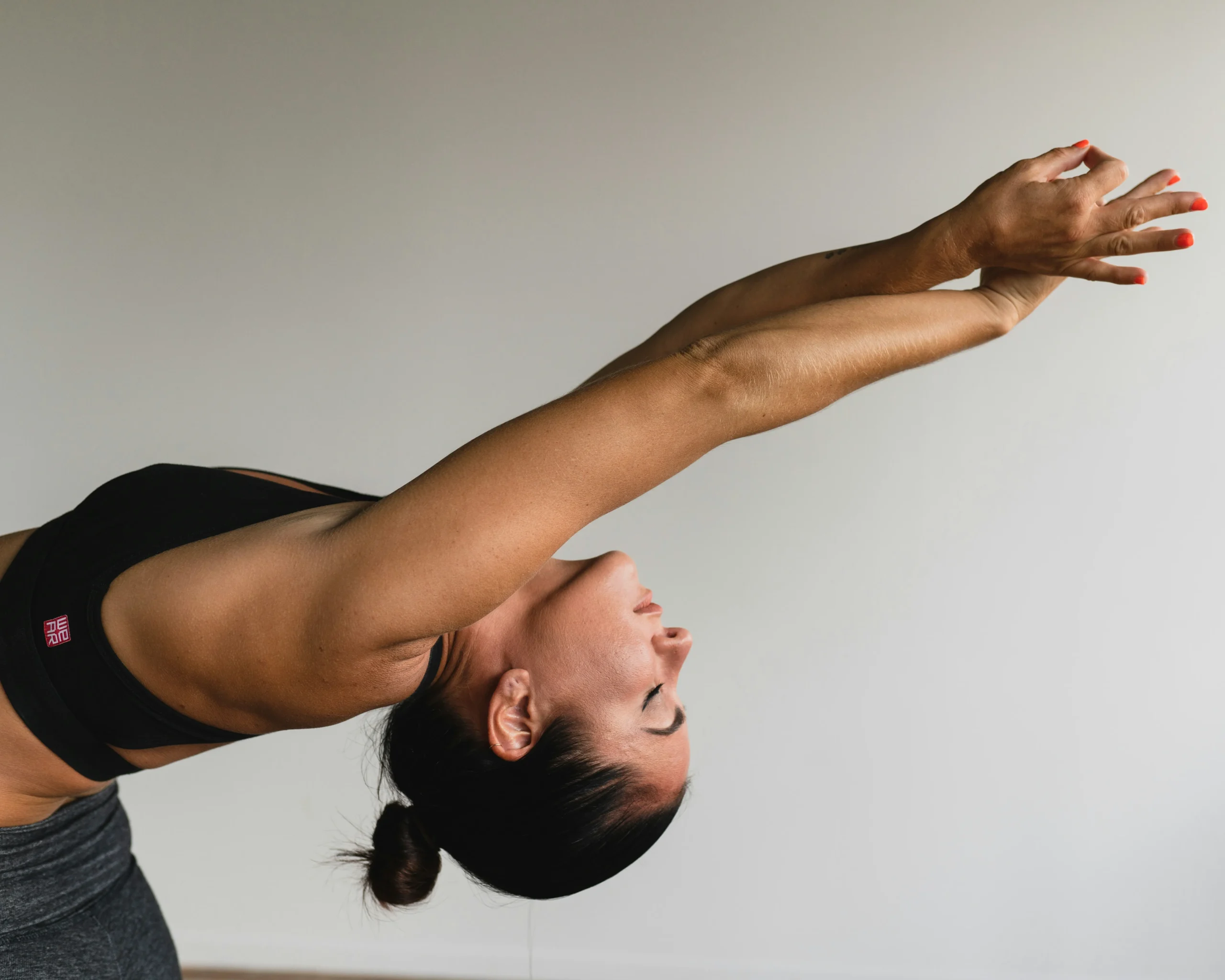Ever wondered why your friends can’t stop gushing about their yoga classes? Or why yoga mats are popping up in offices worldwide? Well, you’re about to dive into the fascinating world of yoga, a practice that’s much more than just interesting body moves. Let’s unfold the mat on this ancient tradition that define yoga as taken a modern twist, turning skeptics into yogis, one breath at a time!
The term “yoga” originates from the Sanskrit word “yuj,” which translates to “to yoke” or “to unify.” Broadly, it signifies the integration of one’s personality and the process of achieving unity within oneself, with the external world, and with the ultimate foundation of existence. Humans typically experience a variety of conflicting thoughts, emotions, and energies. Yoga serves as a method for self-integration.
Table of Contents
Section 1: The Traditional Roots of Yoga
Flashback a few thousand years, and we’re in ancient India—the birthplace of yoga. Imagine sages on the banks of the Ganges, meditating and devising postures that would one day become a global fitness phenomenon. Yoga wasn’t just a workout routine; it was a way of life, intertwined with the spiritual practices and philosophical quests of the time.
Philosophical Foundations
Speaking of philosophy, let’s talk about the backbone of traditional yoga—the Yoga Sutras of Patanjali. Picture this ancient text as the ultimate guidebook of its era. Compiled around 400 CE, the sutras lay down the eight limbs of yoga, charting a course from moral codes to physical postures, right up to meditation and enlightenment. This isn’t your average gym class; it’s a journey to inner peace and self-discovery.
So, there you have it—the seeds of yoga, planted deep in rich soil of spirituality and ancient wisdom. As we roll out our yoga mats today, we’re not just doing a great service to our bodies but connecting with a practice that has evolved over millennia. Ready to see how yoga transformed from ancient art to modern magic? Let’s keep rolling!
Section 2: Yoga As We Know It Today
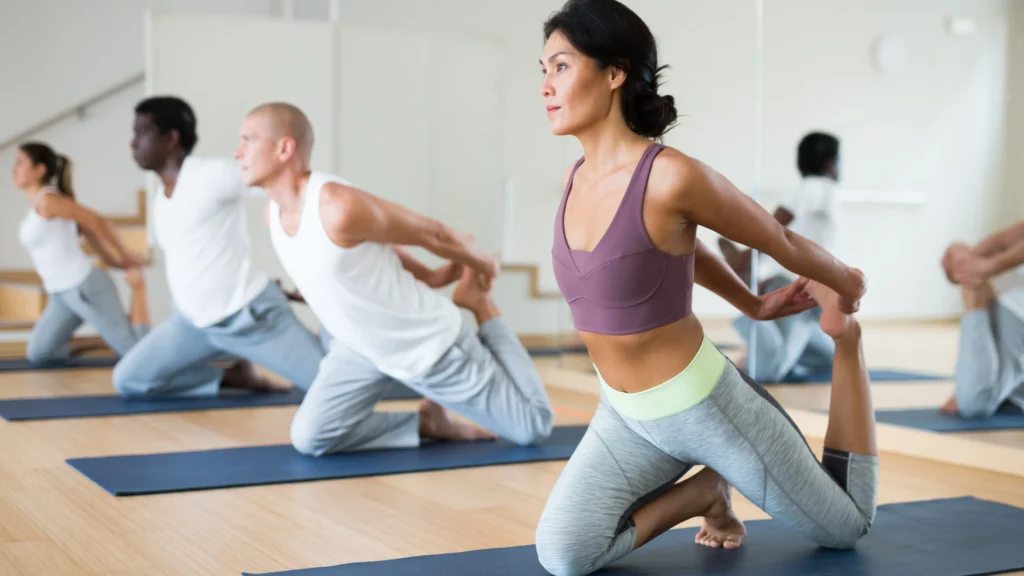
Forms and Styles
Fast forward to the present, and yoga has shape-shifted into an array of styles that could make your head spin (or should we say, your chakras align?). Whether you’re in a bustling city or a tranquil town, there’s a flavor of yoga for everyone. Let’s break it down:
- Hatha Yoga: Think of it as the all-rounder—perfect for beginners looking to dip their toes into the yoga pool. Hatha focuses on basic postures at a comfortable pace, great for those looking to stretch, strengthen, and unwind.
- Vinyasa Yoga: If yoga had a dance-off, Vinyasa would be front and center. It’s all about flow, baby! Sequences of postures matched with breath make this style both a dynamic workout and a moving meditation.
- Iyengar Yoga: Grab your props! Iyengar is the meticulous cousin in the yoga family, with a focus on alignment and precision, often using blocks, straps, and bolsters to get each pose just right.
- Bikram Yoga: Turn up the heat! Bikram classes, performed in a sauna-like room, consist of a set series of 26 postures designed to sweat out toxins and deeply stretch those muscles.
Each style offers a unique spin on the ancient practice, proving that yoga is not just adaptable but thriving in the hustle and bustle of modern life.
Read more from Medical News to learn about the philosophy of yoga more.
Yoga in the Western World
The journey from the serene banks of the Ganges to the neon-lit streets of New York City is as fascinating as it sounds. Yoga hit the Western world like a storm in the late 19th century, thanks to trailblazers like Swami Vivekananda, who introduced the spiritual and philosophical aspects of yoga to the Western audience. Fast forward a century, and yoga studios are as commonplace as coffee shops.
What’s truly remarkable is how yoga has woven itself into the fabric of Western wellness. No longer an exotic novelty, it’s a staple in the fitness regime of millions, cherished for its ability to provide a much-needed escape from the digital overload and frenetic pace of modern life. Yoga today isn’t just a practice; it’s a global phenomenon that bridges the gap between physical health and mental serenity.
In this vibrant tapestry of modern yoga, we see a beautiful blend of the old and the new, each thread enriched by the other. As we transition to the next section, let’s explore how today’s yoga goes beyond physical workouts to enhance every aspect of our lives.
Section 3: Defining Yoga Beyond the Mat
Mental and Spiritual Aspects
Let’s get real—yoga is more than just an Instagram-worthy pose. It’s a tool for tuning in, not just tuning out. Beyond the physical postures, yoga dives deep into the realms of mental and spiritual health. It teaches us to breathe through the chaos of daily life, enhancing mindfulness and reducing stress. Studies show that regular yoga practice improves concentration, memory, and even emotional stability. Who knew that bending could mend, not just the body, but the mind too?
Yoga as a Lifestyle
Imagine starting your day with a sun salutation, finding your balance with some midday meditation, and unwinding with deep breathing exercises at sunset. For many, yoga isn’t just a hobby; it’s a way of life. It’s about making choices that align with a more mindful and compassionate existence. From the foods you eat to the way you interact with others, yoga encourages a lifestyle that values health, sustainability, and inner peace. It’s about being present in the moment and living with intention—pretty powerful stuff for just a “stretching” routine, right?
The Community Connection
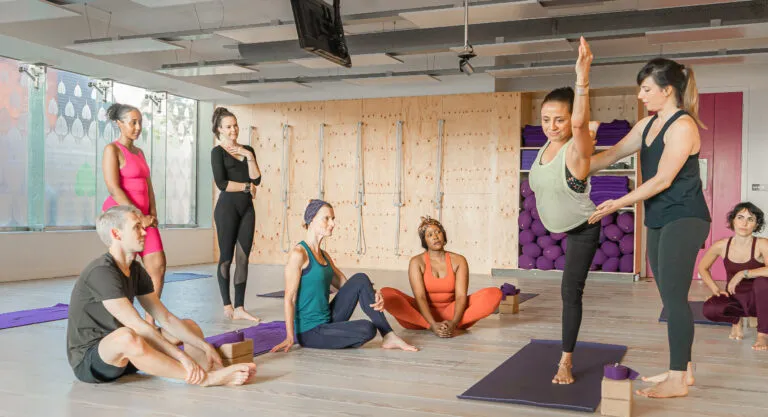
Step into any yoga class, and you’ll feel it—the sense of community. Whether it’s sharing a smile with the person on the next mat or the collective energy of a roomful of synchronized breathing, yoga builds connections. These communities become spaces of support, learning, and growth. They extend beyond the studio, with yoga festivals, retreats, and online forums fostering a sense of global unity and belonging.
Ethical and Philosophical Teachings
Yoga is steeped in ethical practices known as the Yamas and Niyamas, which provide guidelines on how to live a virtuous life. These principles encourage non-harming, truthfulness, non-stealing, moderation, and contentment. By integrating these ethical teachings into daily life, practitioners of yoga do more than just exercise; they cultivate a moral compass that guides their interactions and decisions.
Sustainability and Yoga
Interestingly, the mindfulness promoted by yoga often leads to a greater awareness of environmental impact. Many yogis find themselves drawn to sustainable living practices, from choosing eco-friendly yoga gear to supporting local, organic farms. It’s all about creating a sustainable lifestyle that reflects the harmony and balance yoga teaches us.
Section 4: The Science Behind Yoga
Physical Benefits
Let’s get down to the nitty-gritty—what does yoga actually do for your body? If you think it’s all about becoming a human pretzel, think again. Yoga packs a powerhouse of health benefits that science backs up. From enhancing flexibility and building muscle strength to boosting cardiovascular health and reducing inflammation, yoga does it all. Research even shows that yoga can lower blood pressure, cholesterol levels, and blood sugar, making it a key player in preventing heart disease and diabetes.
Read more about Healthline article about 16 benefits of yoga that are supported by science
Mental Health Miracles
Yoga isn’t just a physical workout; it’s a mental workout too. Numerous studies highlight how yoga can be a lifeline for those battling anxiety, depression, and stress. By promoting relaxation and stimulating the parasympathetic nervous system (that’s your body’s rest-and-digest system), yoga helps decrease levels of cortisol, the stress hormone. Regular practitioners often report higher levels of serotonin, the feel-good neurotransmitter, making yoga a true mood enhancer.
Yoga Therapy
Beyond general practice, yoga has evolved into a therapeutic form. Yoga therapy is tailored to individual needs, addressing specific health issues such as chronic pain, arthritis, and fibromyalgia. It’s not just about adapting poses; it’s about creating personalized programs that support healing and recovery. Hospitals and clinics increasingly include yoga therapy in their treatment plans, recognizing its benefits in holistic health management.
Neurological Benefits
Ever wondered why you feel so blissed out after a yoga session? Let’s talk about your brain on yoga. Studies using MRI and EEG technology have shown that yoga literally changes your brain, increasing grey matter density in areas responsible for memory, empathy, and stress regulation. Regular yoga practice has been linked to better cognitive function and even a decrease in symptoms of PTSD and attention disorders.
Longevity and Anti-Aging
If the fountain of youth were a physical activity, it might just be yoga. With its ability to reduce stress and improve overall physiological functions, yoga can have an anti-aging effect. It keeps the body supple, improves joint health, and enhances vitality, helping you feel younger and more energetic. Plus, the meditative aspects of yoga can add years to your life by keeping your mind sharp and clear.
According to an article called “Yoga for Healthy Aging: Science or Hype?”, numerous well-conducted studies demonstrate that yoga positively impacts cellular aging, mobility, balance, mental health, and cognitive decline prevention—key areas of interest for the elderly.
Section 5: Yoga in Modern Culture
Yoga and Social Media
In the age of Instagram and YouTube, yoga has found a flashy new studio—social media. These platforms are bustling with vibrant yoga communities that share tips, tricks, and of course, the obligatory yoga pose snaps. Influencers sporting the latest athleisure styles lead flows from picturesque beaches and serene mountaintops, bringing yoga into the daily feeds of millions. While some purists worry about the superficiality this might promote, there’s no denying the positive aspect: more visibility has made yoga accessible to a broader audience than ever before.
The Business of Yoga
Yoga isn’t just a spiritual practice; it’s big business. The global yoga industry is booming, estimated to be worth billions of dollars. From eco-friendly yoga mats to high-tech yoga pants that promise to enhance your poses, the market is flooded with products catering to yogis of all levels. Studios offer a myriad of classes, workshops, and teacher training programs, each designed to deepen practice and cultivate a new generation of yoga teachers. This commercial aspect has made yoga a significant economic force, driving innovation and accessibility.
Yoga and Celebrity Culture
When your favorite celebrities are also yoga enthusiasts, you know it’s made it big. Actors, musicians, and athletes tout yoga’s benefits, from improved flexibility and strength to mental clarity and reduced stress. Their endorsements have helped propel yoga into the mainstream, making it part of everyday conversation and lifestyle choices. It’s not just about physical health—celebrities often speak about yoga as a critical component of their mental health regimen.
Integration in Healthcare
Recognizing the benefits outlined by both ancient wisdom and modern science, healthcare professionals have begun integrating yoga into preventative and therapeutic practices. Hospitals offer yoga classes as part of holistic treatment plans for patients with cancer, heart disease, and mental health disorders, acknowledging yoga’s role in healing and recovery. This blend of eastern and western medicine showcases yoga’s versatility and effectiveness in promoting health and wellness at all levels.
According to same study of “Yoga for Healthy Aging: Science or Hype?” claims that given the low expense associated with community and home-based yoga interventions, policymakers are considering yoga as an economical option to decrease healthcare costs and enhance results in an expanding elderly population.
Yoga Education and Advocacy
As yoga’s popularity grows, so does the push for more educated and authentic practice. Numerous organizations and nonprofits have emerged, dedicated to preserving the integrity of yoga practices and promoting its benefits. These groups work to ensure that yoga remains inclusive and accessible while maintaining high standards for teacher training and practice methods. Through advocacy and education, they strive to keep yoga true to its roots and beneficial for all.
Section 6: Personal Stories
Transformations Through Yoga
Meet Emily, a software developer from Silicon Valley, who turned to yoga to manage her crippling anxiety and burnout from the high-pressure tech industry. Initially skeptical, she found that within just a few months, yoga not only alleviated her stress but also transformed her outlook on life. Her story is a testament to the profound impact yoga can have on mental health and personal well-being.
Then there’s Marcus, a retired veteran, who discovered yoga as a way to cope with PTSD. For Marcus, yoga provided a safe space to reconnect with his body and calm his mind, gradually easing the nightmares and flashbacks that haunted him. His journey highlights yoga’s therapeutic power, offering hope and healing to those grappling with deep-seated trauma.
Conclusion of Define Yoga
As we’ve journeyed through the history, science, and personal impact of yoga, it’s clear that this ancient practice offers more than just physical benefits—it’s a holistic approach to better living. Yoga teaches us to define yoga as harmonize our bodies with our minds and spirits, fostering a sense of well-being that transcends the mat. Whether it’s through the meditative stillness of a morning routine or the communal warmth of a packed class, yoga has the power to transform, heal, and unite.
In our modern world, where the pace of life seems only to accelerate, yoga provides a much-needed pause, a moment to breathe and recalibrate. It’s not just a workout; it’s a way of experiencing and engaging with the world more deeply. By embracing yoga, we tap into a tradition that has nurtured countless generations, finding clarity and peace in the midst of our chaotic lives.
Take The First Step!
Are you ready to take the first step on your yoga journey? Whether you’re a complete novice curious about your first class or a seasoned yogi looking to deepen your practice, there’s a place for you in the yoga community. Start today by finding a local studio, signing up for an online class, or simply unrolling a mat in your living room to live what stands for define yoga. Explore the different styles of yoga and connect with others who share your interest.
Remember, yoga is not about perfecting a pose but about progressing on your personal path to wellness. Share your experiences, inspire others, and become part of a global movement that promotes health, peace, and unity. Unroll your mat, take a deep breath, and embrace the transformative power of yoga. Namaste!

